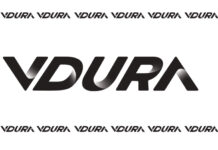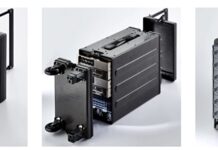Samsung has been slow to develop QLC (4bits/cell) SSD products, compared with Intel and Micron. But it appears to be catching up, judging by a roadmap unrolled at its San Jose TechDay event last week.
Tom’s Hardware and Anandtech attended the show and their reports were the source for much of the information here as Samsung is yet to share this more widely.
The company discussed several upcoming QLC products which use 9x (90+) layer 3D NAND. Samsung did not disclose the number of layers. This, the fifth generation of its V-NAND (3D NAND) technology, is a single stack die and not a “string-stack” of, for example, 3 x 32-layer dies.
Samsung says its competitors use string-stacking in their 96-layer product.

A v6 V-NAND will have 100 or so layers and may use string-stacking. That will be followed by v7 to v10, with a route to 500 layers in which string-stacking will definitely feature.
Samsungs’s enterprise SSD product naming scheme uses indicative prefixes:
- SM – MLC (2bits/cell) NAND product
- PM – TLC (3bits/cell) product
- BM – QLC (4bits/cell) NAND
Retail products have different naming schemes, such as PRO and EVO.
BM QLC drives
Four new QLC SSDs are on the roadmap:
- BM1733 and BM9A3 enterprise NVMe SSDs,
- BM1653 enterprise SAS SSD,
- BM991 client NVMe SSD.
The BM1733 has both NF1 and U.2 form factors, up to 32TB of capacity, a dual-port PCIe gen 4 interface, and sequential speed of up to 10GB/sec.
Wells Fargo senior analyst Aaron Rakers said Samsung will bring out a 512Gb QLC die alongside its existing 1TB QLC chip, which operates at 1.4Gb/sec. Apparently it will have 37 per cent lower read latency and 45 per cent lower program latency relative to an unknown competitor’s 1Tb QLC NAND. Rakers thinks Samsung is comparing itself with Micron.
Z-SSD
Z-SSD is Samsung technology designed to make SSDs react more quickly and perform faster. In other words, it bridges the SSD – 3D XPoint gap.
XPoint is a phase change memory technology that has near DRAM speed and costs more than flash. So far only Intel has turned this into commercially available product, with its Optane chips. These are made at the Intel-Micron joint venture, IM Flash Technologies foundry in Lehi, Utah. But the JV is likely to be taken into sole Micron ownership and we can anticipate Micron-branded XPoint products in the second half of 2019.
Second generation Z-SSDs are coming in SLC and MLC (2bits/cell) forms. Gen 1 Z-SSD was an SLC (1 bit/cell) drive with reduced size wordlines and bitlines, making it faster in operation than ordinary SLC drives. It has a 64Gb capacity, 30us read latency and 100us write latency.
A gen 1 Z-SSD was the SZ985 which had an 800GB maximum capacity.
The Gen 2 Z-SSD, due in the second 2019 quarter, comes in both SLC and MLC (2bits/cell) form, with the SLC version coming with a 128Gb die and read/write latencies of <10-30us/70us.
Two SLC gen 2 Z-SSDs were revealed: the SZ1733 and SL1735.
The dual-port SZ1735 has 4K read latencies of ~16us, random read/write IOPS of 750,000 and 250,000, and sequential bandwidth of up to 3GB/sec. It will have a 5-year warranty, support up to 30 drive writes per day, and its capacity will run up to 4TB.
No SZ1733 details were available, but both it and the SZ1735 support PCIe gen 4.
The capacity of the MLC Z-SSD die is a logical 256Gb, and its read and write latency values are 5us/150us. This is impressively fast. Specific MLC Z-SSD products will be revealed in the future.
Future Z-SSDs will operate at up to 12GB/sec using the PCIe gen 4 interface.
QVO drives
Samsung also mentioned, without providing any details:
- 860 QVO SATA SSD
- 980 QVO NVMe SSD
The QVO moniker could indicate a 9x layer QLC consumer drive with the EVO term indicating 64-layer TLC product.
PM drives
The PM1733 follows on from the PM1723b and its capacity ranges from 1.6TB to 30.72TB. I has a dual-port PCIe gen 4 interface and runs at 8GB/sec for sequential reads and 3.8GB/sec when sequentially writing. The random read/write IOPS values are 1.5 million and 250,000 – the drive is heavily read-optimised.
Its predecessor the PM1723b operates at 3.5GB/sec – thank you, gen 4 PCIe.
Samsung also outlined new products in its 64-layer TLC (3bits/cell) portfolio, using v5 technology. A PM981a client NVMe drive will be the follow-on to the PM981, while a 970 EVO Plus will succeed the 970 EVO retail SSD. The capacity levels stay the same, running from 250GB to 2TB, but were told sequential read speeds will increase. However, Samsung says the 970 EVO Plus will run at 3GB/sec in comparison to the 970 EVO which has a 2.5GB/sec sequential write rating and a 3.5GB/sec sequential read speed, meaning the 970 EVO Plus will have a slower red speed.
We’re querying the read speed discrepancy with Samsung.
The random IO speed of the PM981a will be similar to that of the 970 EVO and 970 EVO Plus.
A PM983a TLC drive is the successor to the data centre PM983, with capacity doubled to a maximum of 16TB. These TLC drives do not use SLC caches to accelerate writes, unlike Samsung’s consumer TLC and QLC drives.
The PM971a NVMe client BGA SSD will be succeeded by a PM991 that nearly doubles random IO and sequential write speed, with sequential read speed increasing by 50 per cent.
The PM1643 enterprise SAS drive will give way to the PM1643a with a 20 per cent boost in random write performance but maximum capacity is unchanged at 30.72TB.
Samsung will move its NAND design to a Cell over Peripheral architecture, with the bit-storing cells built on top of the CMOS logic needed to operate the die. Intel and Micron have a similar CMOS-under-Array design and both schemes make scaling up 3D NAND capacity more practical.








